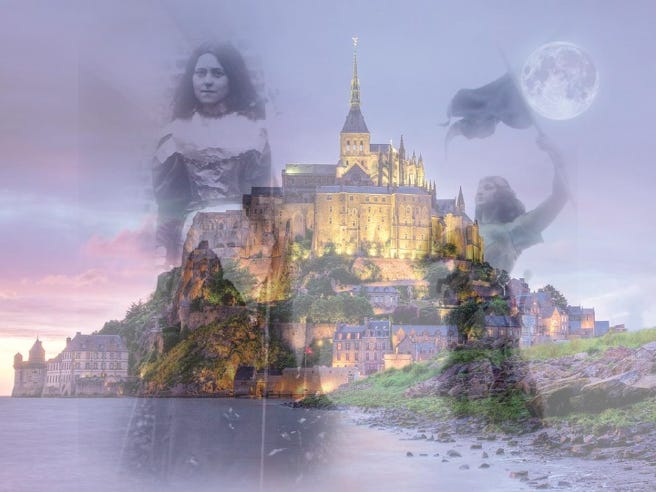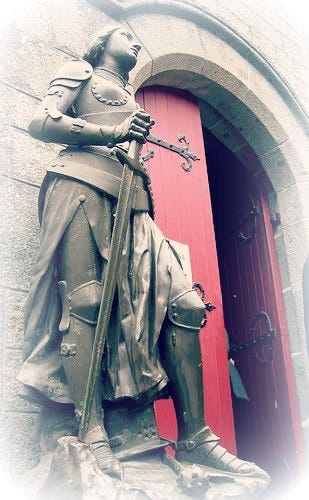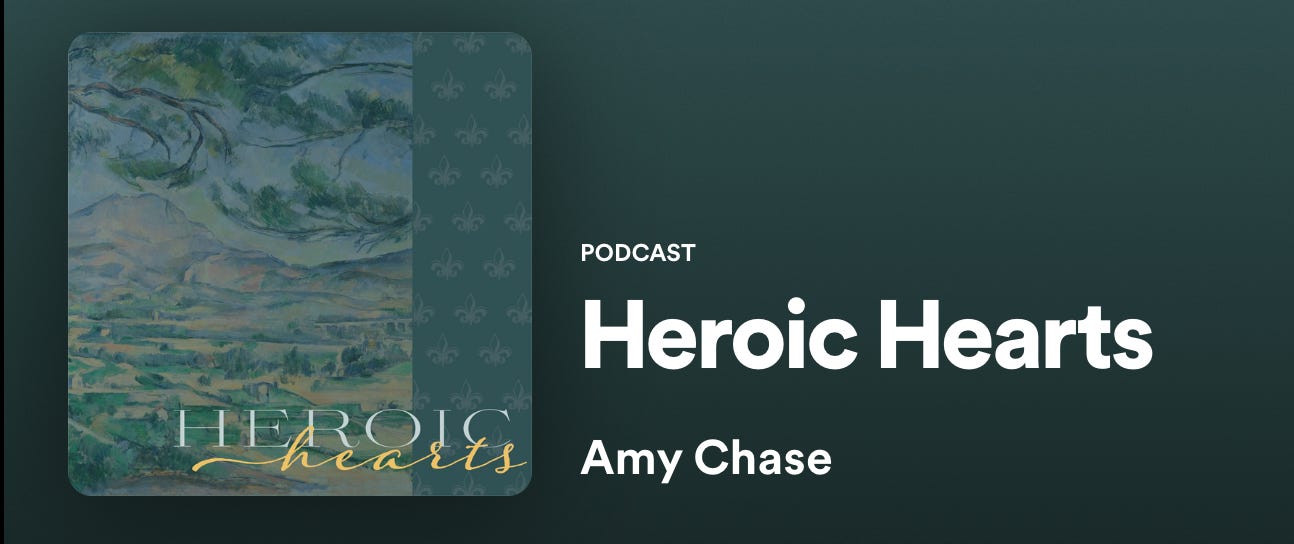The Dove and Rose offers free and paid subscriber options. Publications from my books are paid subscriber only. Much of the rest is free. If you enjoy The Dove Rose regularly, consider becoming a monthly or yearly paid subscriber.
I also have a tip jar in the main menu and after each post. If you enjoy a post and want to make a one-time contribution to my work, the gesture will be much appreciated!
Most importantly, enjoy yourself because I appreciate that you are here.
1977 – Normandy, France
I stood staring at the modestly sized statue of a young medieval warrior perched outside the chapel. A small group of us who recently graduated from high school in Guymon, Ok, were visiting the island fortress of Mont Saint-Michel off the coast of Normandy in northwestern France. We were finishing a six-week cultural and language studies field trip where each of us had been housed with a family living in Brittany, a Western French region extending from the mainland into the Atlantic Ocean just south of the British Isles. Our group was preparing to take a bus to Paris, where we would spend a night before boarding a plane back to the States.
Mont Saint-Michel is a must-see for any tourist or cultural studies traveler, and our itinerary did not disappoint. The ancient monastery at the top of the small hill just off the coast looks like a castle floating on the sea. At night the lights give Mont Saint-Michel an almost surreal appeal. It certainly is a spiritual place with a spiritual history to it, one going back to the early Middle Ages.
Mont Saint-Michel also has a military history. Due to its strategic location in the southern English Channel, it was a fortress from ancient times. During the 14th and 15th century Hundred Years War between France and England, the occupants of Mont Saint-Michel used their strategic advantage. They never surrendered to the English, who otherwise occupied the whole of Normandy and, we should note, northern France in general due to their strategic alliance with the French Burgundians.
In the early 15th century, England was pressing hard on France, or what was left of France. The French “Dauphin,” or “heir apparent” to the throne, hid south of the Loire River in Chinon. The critical passing-over point for the English army to gain entry into the heart of France was at Orléans, sitting on the north bank of the Loire. The French Armagnac sympathizers (those allied with the Dauphin as opposed to the Prince of Burgundy) still held Orléans. If the English could seize control of Orléans, they would pour into the Dauphin’s France in short order. They would take control of all of France and subjugate the French crown to the English. The English would own both crowns. The English put the city under siege in the Fall of 1428. The Dauphin was on the verge of abandoning France and fleeing to Spain or France’s longtime ally, Scotland. It was only a matter of time.
The inevitable, however, did not happen. Miraculously, the French defeated the English at Orléans and raised the siege. More miraculously, the French continued routing the English out of the Loire Valley. Even more miraculously, the trembling Dauphin, Charles VII, shortly after was crowned King of France at the cathedral in Rheims (deep in Anglo-Burgundian territory, northeast of Paris) on July 17, 1429, only nine months after the English enclosed their hands firmly around France’s neck. During this time, and during the entire Hundred Years War, Mont Saint-Michel, sitting squarely in the thick of English occupation, never surrendered. The island is almost impenetrable, with a land bridge only at low tides. The fortress has a colorful and exciting history for sure.
I stood staring at the modestly sized statue. Looking around, I did not sense that others were as interested as I was. There was much activity, and our French teacher, Linda Bowling, hustled around doing her typically marvelous job of keeping us organized and doing so with high enthusiasm and energy. Amid the hustle and bustle, I stood still. I stood staring at the statue.
The statue intrigued me. Indeed, it did not intrigue me from a purely denominational, religious perspective. Most of what I had experienced in France was Catholic. I was a Protestant young man, having grown up in the American Bible Belt. Our family was staunchly Methodist. My father, an avid fisherman, was among the best friends of the local Methodist minister, also an avid fisherman. In fact, the two of them owned a small fishing boat together. We used to call it the “Louie boat” after the minister’s first name.
Most, though not all, of my friends were from other denominations. Guymon had about every Protestant denomination. A couple of independent evangelical churches popped up when that movement started gaining momentum in the 1970s. The largest church in town was the First Baptist Church, which sat across the corner from our United Methodist Church. Despite the plethora of church groups, we never gave it much thought, really. At least I did not. We would hang out at each other’s church youth groups and occasionally attend camps or youth retreats.
There was a small Catholic church off on a side street. I never knew much about it. I remember attending services (I did not know it was called Mass) there, probably around the sixth or seventh grade. To this day, vague memories of that visit still are lodged in my head. The most memorable moment was when everyone got up in the middle of the service and lined up to go to the front. We did not do that in the Methodist Church other than at the every-so-often communion service. However, it was part of the regular routine at the Catholic Church. I made neither head nor tails of that, but I did not give it much thought.
I was standing and staring at this statue, however. I was, in fact, giving this particular object outside of a “church” some thought. I was not sure why.
“Who is that?” I asked Ms. Bowling, who had appeared at my side.
“Ah, c’est Jeanne d’Arc!” (“It is Joan of Arc!”) she exclaimed.
Ms. Bowling quickly ran off to herd some of the others.
I continued to stare at the statue.
“Joan of Arc,” I thought to myself. The name was familiar, for sure. Yet, I could not recall much I had learned about her. I remembered something about burning at the stake. Yes. Did she not burn at the stake? The rest was a blank sheet. Even after my six weeks in Brittany, I would not have done well on a French history exam.
I turned with a typical “whatever” shrug. I walked at a clip to catch up with the group, not realizing that Joan of Arc was why the French defeated England at Orléans. She was the reason the French routed the English from the Loire Valley. Joan was why the Dauphin, Charles VII, marched to Rheims to be crowned King of France rather than run away. She was the reason that France kept her independent crown. Joan of Arc was why France remained Catholic after the Protestant Revolution. She was the reason France developed into the nation-state we know today. That is who Joan of Arc was.
I did not realize the historical, religious, and spiritual significance of the person whose image that curious statue represented. I also did not know the historical, religious, and spiritual relevance she would have in my personal life.
Joan of Arc saved France’s life. I had no “earthly” idea then that she would save mine.
Check out The Dove and Rose podcast here and on Anchor, Spotify, or Apple.
Check out the Heroic Hearts podcast on Substack, Spotify, or Apple. Heroic Hearts is a podcast about healing, enchanting, and elevating our hearts through the stories and spirituality of St. Joan of Arc and St. Therese of Lisieux. Co-hosted with Amy Chase.






